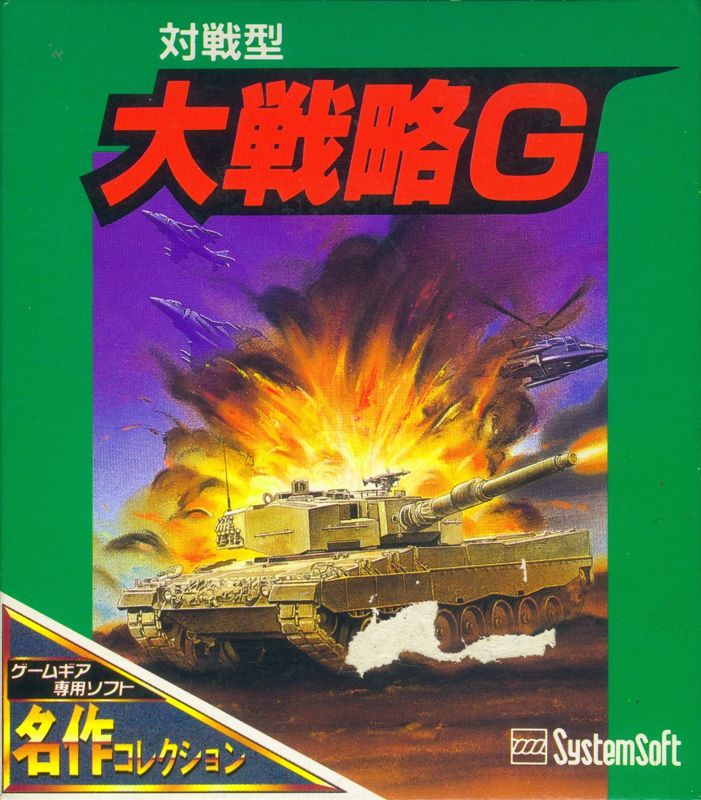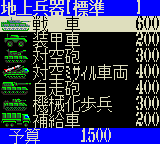Retro Replay Review
Gameplay
Taisen-gata Daisenryaku G delivers a deeply strategic turn-based experience on the Game Gear, breaking each round into production, movement and combat phases. As a player, you must balance your funds, which rise in proportion to the number of cities and airbases you control, against the cost of producing new units. Thoughtful planning is essential—overextend your frontlines and risk running out of supplies; hold back and the enemy might encircle your capital.
(HEY YOU!! We hope you enjoy! We try not to run ads. So basically, this is a very expensive hobby running this site. Please consider joining us for updates, forums, and more. Network w/ us to make some cash or friends while retro gaming, and you can win some free retro games for posting. Okay, carry on 👍)
The map grid uses “fake hexagons,” where square tiles are staggered to simulate six-directional movement. This seemingly simple tweak adds depth to unit positioning: forests offer defensive bonuses, plains facilitate rapid advances and mountain passes funnel armored divisions into chokepoints. Mastering how different terrains affect movement and defence is crucial to turning the tide of battle in your favour.
Units gain experience over time, reflecting their battlefield success. Each squadron starts with ten soldiers or aircraft, and every victorious engagement chips away at enemy forces rather than wiping them out entirely. Veteran units become more reliable, making experienced divisions valuable assets that can tip a drawn-out war. Managing attrition through replenishment in friendly cities and deploying supply trucks for frontline ammo resupply adds a logistical layer seldom seen on 8-bit hardware.
Production takes place at each city or airbase within five hexes of your capital, provided you have the funds. Since each location can only build one unit per turn, you often face tough decisions: mass-produce infantry to hold territory, or save up for a heavy tank to punch through enemy lines? Ultimately, the economy and your willingness to defend supply routes determine whether you can field an unstoppable force or end up outpaced by a more frugal foe.
Graphics
On the Game Gear’s small, 160×144-pixel screen, Taisen-gata Daisenryaku G manages to convey a clear, functional battlefield. Units are represented by simple sprites—tanks, infantry and aircraft each have distinct icons—while terrain features use a limited palette to differentiate forests, mountains and water. Although not as detailed as contemporary home‐console titles, the visuals remain readable under pressure, which is essential for a game of this complexity.
Animations are sparse but effective. Attacks trigger brief explosions or aircraft flying overhead, adding just enough visual feedback during combat without slowing down the flow. The user interface employs straightforward menus and on-screen prompts, enabling quick unit inspections and orders even on the go. Counters for remaining strength and experience are clear, ensuring you never lose sight of a unit’s status.
Colour contrast helps maintain clarity, though the Game Gear’s backlight can sometimes wash out subtler terrain hues. Landscapes remain distinct, however, and unit counters stand out against varying backdrops. Developers wisely opted for function over flair, prioritising legibility so that strategic decisions, rather than pixel art, remain at the forefront of the experience.
Story
At its core, Taisen-gata Daisenryaku G pits the fictive Red and Blue nations against each other in a classic war of conquest. While there is no cinematic intro or branching narrative, the game’s thirty maps each present a unique theatre of operations. From sprawling plains to mountain-ringed fortresses, every scenario tells its own story through strategic challenges and shifting objectives.
The lack of character-driven drama allows players to craft their own war stories. A miscalculated advance might see your mechanised infantry cut off and besieged, while a well-timed air strike can obliterate an unsuspecting armoured column. As you replay maps from different sides, emergent narratives of heroic last stands and daring breakthroughs become the heart of the experience.
Victory comes not from a predefined script but from your tactical ingenuity. Each campaign evolves dynamically: capturing an enemy airport can swing the momentum by denying their bombers, while a well-timed counteroffensive might recapture lost territory before the computer can react. This focus on player-driven outcomes ensures that every battle feels consequential, turning the absence of a formal storyline into a creative strength.
Overall Experience
Taisen-gata Daisenryaku G stands out as a remarkably deep strategy title on handheld hardware. Its tri-phase turn structure, coupled with unit experience and supply mechanics, offers a rewarding challenge for anyone who enjoys methodical planning. The ability to link two Game Gears for head-to-head play further extends its replay value, making it more than a solitary grind against the AI.
While the Game Gear’s limitations cap graphical fidelity and audio immersion, they also reinforce the game’s cerebral focus. Battles unfold at a deliberate pace, allowing time to weigh risk versus reward. If you’re seeking fast-paced action, this may not be your title. But if you relish peeling back layers of tactical nuance—calculating fuel and ammo lines as keenly as advancing armour columns—Taisen-gata Daisenryaku G delivers in spades.
Overall, this port remains a testament to the enduring appeal of classic war simulations. It may lack narrative spectacle, but its systems-driven gameplay ensures countless hours of strategic engagement. For portable strategy enthusiasts, it’s a must-play glimpse into the grand tradition of Daisenryaku that began on home computers and found a surprisingly capable home on a tiny blue handheld.
 Retro Replay Retro Replay gaming reviews, news, emulation, geek stuff and more!
Retro Replay Retro Replay gaming reviews, news, emulation, geek stuff and more!









Reviews
There are no reviews yet.